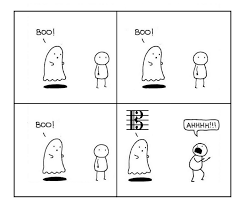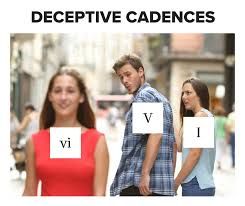What Memes Are Perfect for AP Music Theory?
5 min read•july 11, 2024
Samantha Himegarner
AP Music Theory 🎶
72 resourcesSee Units
Are you procrastinating studying for your music theory test? It's ok, I probably am, too. Studying is hard! And boring... at least most of the time. What is objectively more fun than studying, however, is laughing at memes, and sometimes it can be more effective, too. Whether you are in need of a study break or a little push of motivation to get you started, this round-up of music theory memes will make you smile while also making your brain just a little bit smarter.
Meme #1: A Clef Catastrophe 🎻

image courtesy of musicnotes.com
In this meme, we have a little, hopefully kind of friendly, ghost attempting to scare a human. The ghost tries a few times by saying "boo", but when that does not work, the ghost resorts to something truly horrifying: alto clef.
Alto clef is really only used by violists, as it fits the range of the instrument well. However, all other musicians hate it because it is confusing and useless to all other instrumentalists.
In alto clef, the middle line of the staff is middle C. Every other note falls accordingly. That doesn't sound too difficult, right? WRONG!
In treble clef, the middle line of the staff coordinates to a B. In bass clef, it coordinates to a D.
The corresponding note on alto clef falls right into the middle territory where it doesn't quite make sense to anyone who is more comfortable in treble and/or bass clef. This just makes alto clef a bit more difficult to read for musicians that aren't used to it, making it a little bit intimidating or scary. The human in the comic was certainly scared by it (and I still am a little bit, too).
Meme #2: Deceptively Simple

image courtesy of musicnotes.com
A cadence is just a fancy way of describing the movement of a chord progression, and, therefore, a piece as a whole. There are different kinds of cadences depending on how the composer supports a melody. This meme explicitly talks about deceptive cadences but also discusses authentic cadences.
An authentic cadence is when the dominant (V) chord returns "home" to its tonic (I). Returning to the tonic (or I chord) makes the piece feel complete, and is even more effective coming off of the dominant (V) chord, making it an authentic cadence. But this meme is not about authentic cadences, is it?
A deceptive cadence can be found whenever the dominant (V) chord sounds like it might makes its return to the tonic, but then doesn't. Whereas an authentic cadence has to return to the tonic, a deceptive cadence is a little more lenient in its definition; basically, it is a V to anything that isn't the tonic, although it usually goes to the submediant chord. Deceptive cadences, otherwise called a deceptive progression, are used in place of authentic cadences, and tricks the listener a little bit from thinking a section or piece is complete, just to continue with the progression.
In the case of the meme, the dominant (V) and the tonic (I) are "out together". Knowing that he should be "attracted towards" the tonic (I), the dominant (V) instead is interested in the minor 6th (vi), moving more towards a deceptive cadence instead of an authentic one. Doesn't sound like dominant and tonic's relationship is too authentic, here, does it?
Meme #3: A Grave Error ⚰️

image courtesy of reddit.com
Uh-oh. Writing a parallel fifth or octaves while part-writing is a HUGE no-no. Bach would be incredibly disappointed in you.
In all seriousness, part-writing rules are simply the worst. However, they exist for a reason, and really are important.
In this case, the meme references what happens when including parallel fifths or octaves within part-writing. It is really frustrating because even though the harmonies may not technically be wrong, it just is not good voice leading. Writing perfect consonances such as fifths or octaves, especially while utilizing parallel motion does a few things:
- Confuses the ear and make it more difficult to hear the harmony
- Lightens the texture of the 4-part harmony
Next time you are practicing your part-writing skills, just double check that you aren't doing this! It can be hard, but your grade will thank you for it!
Meme #4: Perfect Authentic Drake-dence

image courtesy of classicfm.com
On the note of part-writing, here is a prime example of exactly what not to do, but also a really good way to fix it! Drake does a good job of pointing out what we do not want and what's good 😎
The example shows a simple I-V progression in the key of C (so a C chord to a G chord), both in the root position. Off to a good start! However, the first chord is voiced as a fifth between the tenor and bass, and an octave in the alto and soprano, and then keeps those intervals and moves them in a parallel motion into the G chord, with parallel fifths, octaves, and a doubled third 🤮
Looking at the second example, it is a much better example of part writing. The only fifth to be found in the example is between the tenor and the bass in the G chord, but because the motion is contrary to get there and doesn't appear anywhere else, this functions effectively. The second part avoids too much parallel motion overall, also using contrary and oblique motion.
(Just for review, parallel motion refers to when two lines are moving in the same direction at the same interval. Contrary motion describes two lines moving in an opposite matter of each other, so like how the bass ascends and the tenor descends in the second example. Lastly, oblique motion is when one part stays the same with moving parts surrounding, like how the G in the alto functions well in both chords, so that tone can stay consistent while all the other parts do the work!)
This is now the second meme about avoiding parallel fifths and octaves during part-writing. I hope now you'll remember not to do it, or will at least recognize it if done accidentally. Just remember, practice makes perfect!
Meme #5: Stepping to Conclusions

courtesy of classicfm.com
Ahhhh, intervals. Gotta love them. This one is just kind of silly. Five whole steps would add up to an augmented 6th. Here's an example below.

We know that C to A is a 6th (because A is the sixth scale degree in the C major scale), and that to augment that interval (augment means to raise by a half step), would turn the A into an A#. Therefore, 5 whole steps is an augmented 6th.
Yeah, this meme is kind of dumb, but it made me giggle, and if anything maybe you'll remember the difference between augmented and diminished.
You can also keep in mind that this same concept applies to a tritone, which is comprised of three whole steps.
Wrap-Up
Ok, that is all the music theory memes I have for now. I hope they helped clear up a confusing concept or help you to remember something that you might forget. Before you get on that grind, remember to take plenty of breaks and drink lots of water. Happy studying!
Browse Study Guides By Unit
🎵Unit 1 – Music Fundamentals I (Pitch, Major Scales and Key Signatures, Rhythm, Meter, and Expressive Elements)
🎶Unit 2 – Music Fundamentals II (Minor Scales and Key Signatures, Melody, Timbre, and Texture)
🎻Unit 3 – Music Fundamentals III (Triads and Seventh Chords)
🎹Unit 4 – Harmony and Voice Leading I (Chord Function, Cadence, and Phrase)
🎸Unit 5: Harmony and Voice Leading II: Chord Progressions and Predominant Function
🎺Unit 6 – Harmony and Voice Leading III (Embellishments, Motives, and Melodic Devices)
🎤Unit 7 – Harmony and Voice Leading IV (Secondary Function)
🎷Unit 8 – Modes & Form
🧐Exam Skills
📚Study Tools

Fiveable
Resources
© 2025 Fiveable Inc. All rights reserved.